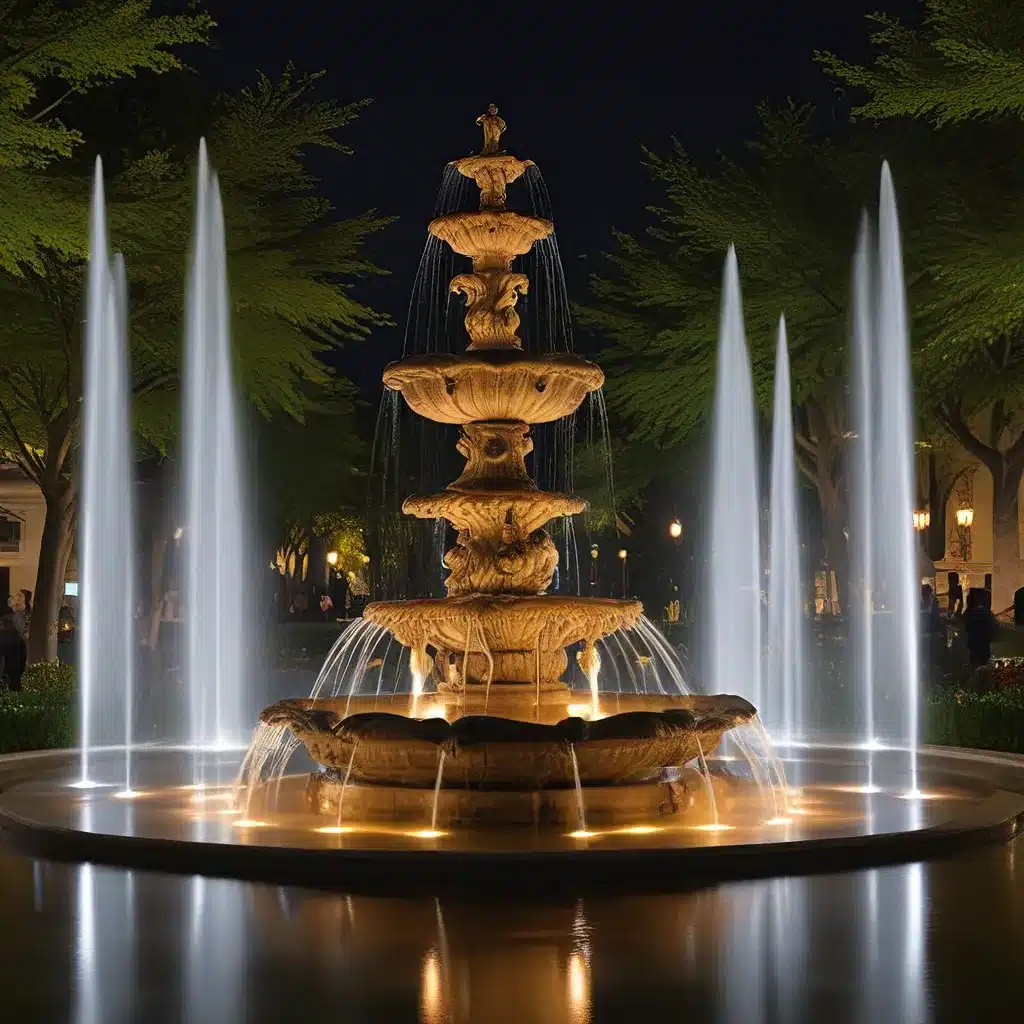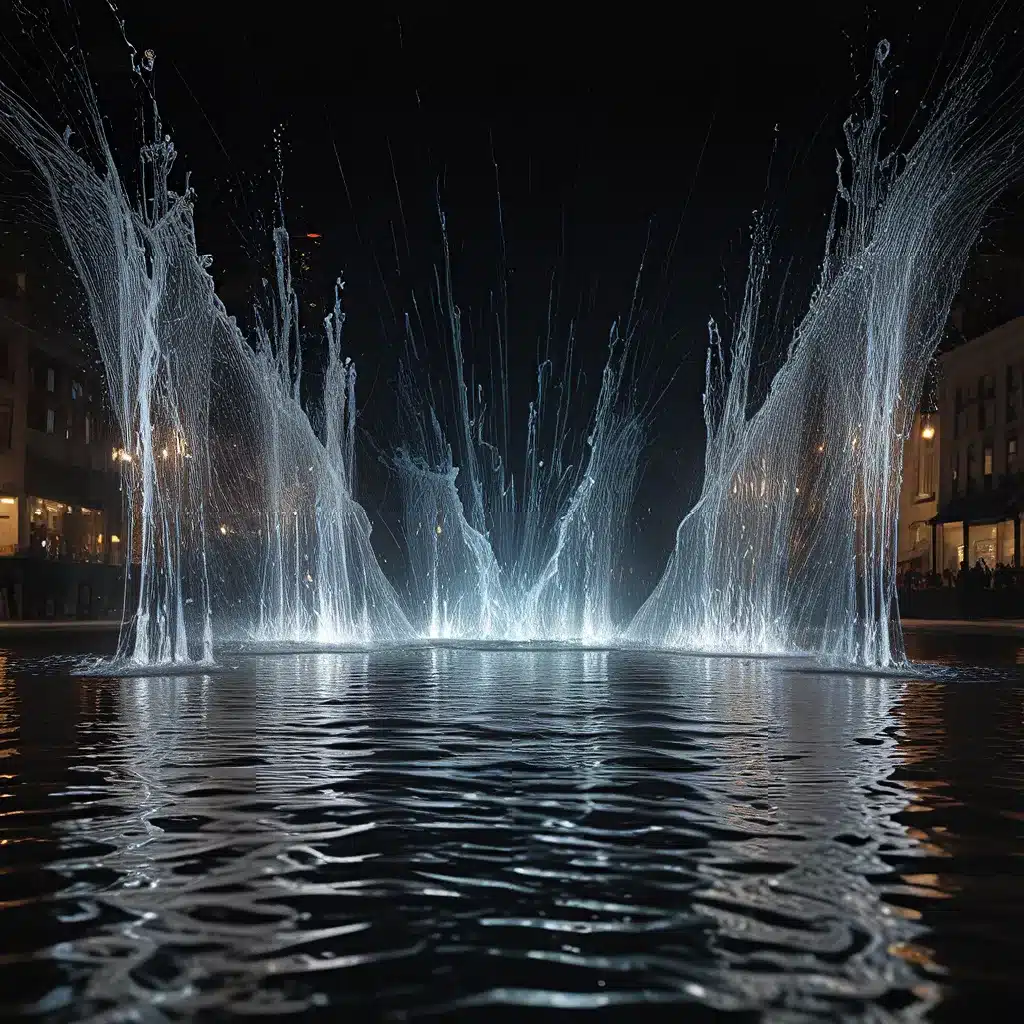
Fountain Design Essentials – Welcome to Fountain Lights
Fountain Design Essentials – Welcome to Fountain Lights

Ah, the captivating allure of water and light – a dynamic duo that has enchanted humankind for millennia! As the Marketing Manager at Fountain Lights, I’ve had the privilege of witnessing firsthand the transformative power of these two natural elements when combined.
It all started when I stumbled upon an ancient Roman poet’s musings. Horace, the renowned scribe, once wrote: “This is what I prayed for, a piece of land – not so very big, with a garden and near the house a spring that never fails and a bit of wood to round it off.” Those words struck a chord deep within me, for they encapsulate the timeless human yearning for a connection with nature – a desire that has endured across cultures and centuries.
Intrigued, I dove deeper into the rich tapestry of history, tracing the intertwined threads of water, light, and their profound impact on the human psyche. From the stylized animals of the Neolithic era to the acanthus leaves adorning Greek temples, the representation of nature has long been a driving force in art and architecture. And the allure doesn’t stop there – cultures around the world have ingeniously incorporated natural elements into their built environments, from the garden courtyards of the Alhambra to the papyrus ponds of ancient Egypt.
As I delved into the research, I discovered a fascinating concept – biophilia. This term, coined by social psychologist Eric Fromm and later popularized by biologist Edward Wilson, refers to the innate human desire to connect with nature and natural systems. Biophilia, it seems, is deeply woven into the fabric of our being, influencing our preferences, our mental well-being, and even our physical health.
The savanna hypothesis, proposed by Gordon Orians and Judith Heerwagen, posits that our landscape preferences are shaped by evolutionary forces, with the open, park-like savannas of our ancestral homelands serving as the ideal blueprint for our ideal environments. And the evidence is compelling – studies have shown that natural landscapes with elements like water, shade trees, and flowering plants consistently elicit more positive emotional responses and lower stress levels than their urban counterparts.
But the power of biophilia extends far beyond mere aesthetics. As the green building movement gained momentum in the 1990s, researchers began to uncover the profound links between environmental quality and worker productivity. Studies by pioneers like Roger Ulrich demonstrated the healing power of nature, with patients recovering more quickly from surgery when afforded a view of the great outdoors.
The translation of biophilia from hypothesis to reality is where the field of biophilic design comes into play. Spearheaded by luminaries like Stephen Kellert and William Browning, this interdisciplinary approach seeks to intentionally incorporate nature-inspired elements into the built environment, harnessing the inherent human-nature connection for the betterment of our physical, mental, and emotional well-being.
One of the key principles of biophilic design is the recognition that not all nature is created equal. Vernacular architecture, for instance, has long recognized the importance of using locally available materials and incorporating design elements that reflect the surrounding ecology. And the concept of Environmental Generational Amnesia reminds us that our perceptions of what constitutes “natural” can shift dramatically over time, underscoring the importance of maintaining a connection with the historical and ecological context of a given place.
Biophilic design can be organized into three distinct categories: Nature in the Space, Natural Analogues, and Nature of the Space. Each of these approaches offers a unique lens through which to view the integration of natural elements, from the direct presence of plants and water features to the more abstract representations of organic forms and fractal patterns.
But what exactly is the science behind the magic of biophilic design? As it turns out, the human experience of nature can be understood through the lens of three interconnected mind-body systems: cognitive, psychological, and physiological.
The cognitive system encompasses our mental agility, memory, and ability to think, learn, and problem-solve. Exposure to nature has been shown to provide opportunities for mental restoration, allowing our higher cognitive functions to take a much-needed break and recharge.
The psychological system, on the other hand, governs our adaptability, alertness, attention, concentration, and emotional well-being. Numerous studies have reported that experiences of natural environments can elicit greater emotional restoration and lower instances of negative mood states like tension, anxiety, and fatigue.
Finally, the physiological system controls our aural, musculoskeletal, respiratory, and circulatory functions. Interactions with nature have been linked to relaxation of muscles, lowering of blood pressure, and reduction of stress hormones in the bloodstream, all of which contribute to overall physical and mental well-being.
As a marketing professional, I’m fascinated by the practical applications of biophilic design and how they can be tailored to specific contexts and user needs. After all, no two spaces are exactly alike – the design strategies that might work wonders for a bustling office environment may not necessarily be the best fit for a tranquil healthcare facility or an energetic educational institution.
One key consideration is the scale and density of the environment. In high-density urban settings, where land is at a premium, the incorporation of biophilic elements may require more creativity and innovation. Strategies like parklets, green walls, and skyrise greenery can help bring nature into the heart of the city, providing much-needed respite and restoration for those confined to the concrete jungle.
Equally important is the speed and rhythm of the space. Individuals moving quickly through a space, such as along a busy highway, may respond better to large, easily interpretable biophilic elements, like swaths of lush vegetation. In contrast, pedestrian-focused environments offer opportunities for more fine-grained details and micro-restorative experiences that can capture the attention and imagination of the observer.
As the Marketing Manager at Fountain Lights, I can’t help but feel a profound sense of excitement about the synergies between our products and the principles of biophilic design. After all, what could be more captivating than the enchanting interplay of water and light?
Our innovative fountain lighting solutions harness the power of these two natural elements to create truly mesmerizing experiences. Imagine a tranquil water feature, its surface reflecting the ever-changing patterns and hues of carefully choreographed lighting – a symphony of sights and sounds that can transport the viewer to a state of calm and wonder.
But the benefits of our fountain lighting go far beyond mere aesthetic appeal. By strategically incorporating biophilic design principles into our products and installations, we’re able to tap into the innate human desire for a connection with nature, eliciting tangible physiological and psychological responses that can enhance health, well-being, and overall quality of life.
Whether it’s the soothing presence of water, the captivating play of light and shadow, or the dynamic and sensory-rich nature of our fountain displays, the Fountain Lights experience is designed to nourish the mind, body, and spirit, offering a respite from the stresses of modern life and a deeply restorative connection with the natural world.
As I reflect on the journey of discovery that led me here, I can’t help but feel a sense of awe and wonder at the ever-evolving field of biophilic design. The science may still be emerging, the patterns may continue to evolve, and the applications may grow ever more diverse, but one thing is certain: the human-nature connection is a fundamental and enduring aspect of the human experience.
Whether you’re a designer, an urban planner, a healthcare professional, or simply someone who appreciates the beauty and serenity of the natural world, I invite you to explore the captivating world of biophilic design and the transformative power of water and light. Who knows where this journey of discovery and innovation may lead us next?
Share to :
Subscribe to our newsletter for the latest in fountain design, innovative lighting ideas, and exclusive tips straight to your inbox. Join the community shaping the future of water features.

Rapid delivery to your doorstep.

Excellence in every product.

Great value for your investment.

Assistance at any hour.
Fountain Lights — Illuminating creativity in every splash!
Copyright © 2023. All Right Reserved